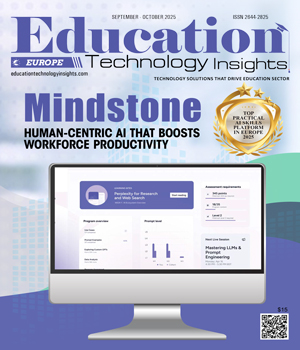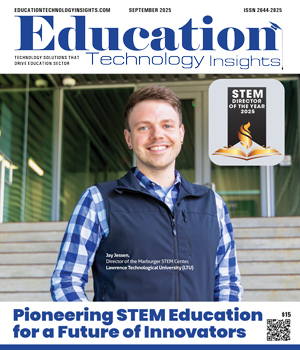THANK YOU FOR SUBSCRIBING
Be first to read the latest tech news, Industry Leader's Insights, and CIO interviews of medium and large enterprises exclusively from Education Technology Insights
Virtualization as a Bridge For Multi-Campus Support
Larvell Davis, Director of Information Technology, VCU School of Pharmacy
 Larvell Davis, Director of Information Technology, VCU School of Pharmacy
Larvell Davis, Director of Information Technology, VCU School of PharmacyIn teaching, learning and innovation n higher education, technology decisions often come down to one question: How can we deliver consistent, reliable experiences to students and faculty across multiple campuses and how can we do it economically and sustainably, without duplicating effort? At the Virginia Commonwealth University School of Pharmacy (SoP), virtualization has become our answer.
From Physical Labs to Virtual Desktops
When I began as Director of Technology in November 2022, one of my first challenges was figuring out how to do “more with less” and how to build a culture of innovation and community with a limited budget. At the same time, I recognized that several of our computer labs were heavily utilized but filled with outdated equipment that no longer met our students’ needs. A change was necessary.
After conversations with faculty, staff, and external stakeholders, we agreed it was time to replace our legacy equipment. The key was how. We realized the University already had infrastructure in place that would allow us to deploy thin clients at a fraction of the cost of traditional desktops. These devices, paired with key virtual infrastructure tools, Citrix and Azure, could provide students with powerful virtual desktops while allowing our team to manage everything centrally. Students would feel like they were working on a high-performance machine but without the overhead of managing dozens of individual systems. Virtual desktops not only provide students with a reliable virtual environment but also an environment that is secure and meets VCU security standards, allowing safe accessibility of key student applications.
Our transformation began in one of the school’s smaller computer labs, also serving as a critical learning space for Pharm.D students. Historically, each workstation required direct imaging, patching, and hands-on troubleshooting. It worked, but it wasn’t scalable. With thin clients, students now log into a Virtual Desktop Infrastructure (VDI) session that delivers a clean, standardized Windows environment. Once they log out, the desktop is released back into the pool, ready for the following user.
“Virtualization gives us a way to do more with less, while keeping the focus where it belongs, on I teaching, learning and innovation”
The shift has been transformational for our PharTech Technology team. We can update, secure and manage the entire lab remotely and centrally without ever physically touching the hardware. For students, the experience is seamless: every login provides the same tools and applications, regardless of where they sit.
Driving Equity Through Technology
The equity implications of virtualization cannot be overstated. In the past, differences in device performance or configuration could affect student learning. Now, every student has equal access to the same high-performing virtual environment. Whether they own a top-of-the-line laptop or an older model, the computing power they need is available the moment they sign in. This consistency levels the playing field. Exams, simulations and coursework run in the same environment for everyone, reducing stress for students and minimizing variability for faculty.
Preparing for Multi-Campus Support
Our next challenge is geographic. The School of Pharmacy operates not only in Richmond, but also at our Inova campus in Fairfax, Virginia. Traditionally, supporting two campuses requires duplicate infrastructure and additional staff time. With virtualization, that equation changes.
We plan to extend the thin client and VDI model to Inova, enabling our Richmond-based PharTech team to support the campus remotely. A student in northern Virginia will log into the same environment as one in Richmond, with identical access and performance. This approach improves efficiency, ensures continuity across campuses and eliminates the need to build duplicate systems.
Beyond Efficiency: Resilience, Flexibility and Equity
Virtualization isn’t just about saving time for IT staff or lowering hardware costs (though it does both); It’s about resilience. In a world where higher education requires agility, remote access and evolving technology capabilities, a centrally managed virtual environment allows us to pivot quickly. If another program or campus requires expansion, we can scale without rebuilding infrastructure from scratch. If faculty needs specialized software, we can deploy it across dozens of desktops with a few clicks. And if students need to work remotely, the same environment can be securely extended beyond the classroom. Most importantly, virtualization supports students from diverse backgrounds who bring all types of personal devices to campus. Some laptops may not meet hardware requirements for advanced applications. Still a virtual desktop removes that barrier, ensuring every student has access to the resources they need, when they need them.
Looking Ahead
Our journey at VCU School of Pharmacy is ongoing. Thin clients and VDI are just one part of a broader modernization strategy that also includes remote support tools, centralized policy management and exploring how AI might enhance IT operations and classroom learning. But virtualization has already given us something foundational: a bridge between campuses, a fairer experience for students and a more sustainable model for IT support. In higher education, resources will always be finite. Virtualization gives us a way to do more with less, while keeping the focus where it belongs, on teaching, learning and innovation. Ultimately, our goal is to empower the next generation of pharmacists with technology that not only supports their education but is seamlessly tailored to their success.
Read Also
From At-Risk to At-Promise: The Language Revolution Higher Education Needs
Teaching Tomorrow: How Western Governors University Is Redefining Teacher Preparation
Shaping Future Engineers Through Innovation and Hands-On Learning
From Isolation to Interaction: Reimagining Technology for Human Connection
Building an Understanding of AI in Learning Environments
Integrating SEL, Digital Citizenship, and AI Literacy in K–8 Schools

I agree We use cookies on this website to enhance your user experience. By clicking any link on this page you are giving your consent for us to set cookies. More info

However, if you would like to share the information in this article, you may use the link below:
www.educationtechnologyinsightseurope.com/cxoinsights/larvell-davis-nid-3466.html





















